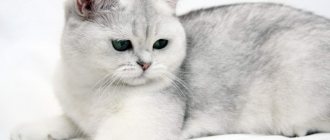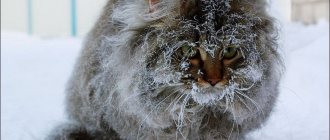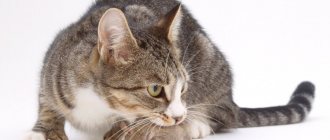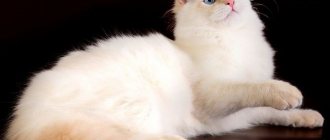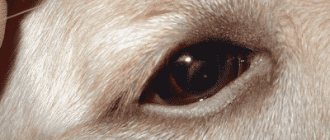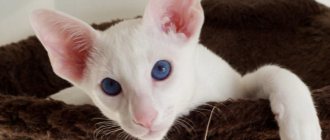Origin story
A domestic cat and a wild lynx once met in the wild prairies, fell in love with each other, and had furry babies... This legend is still passed on from mouth to mouth by lovers of beautiful stories, but it has already been proven (and there are a number of reasons for this) that this is just a fiction.
And the facts are as follows: for many years, felinologists have been trying to breed a new breed that resembles a proud lynx. Domestic cats of all possible breeds were crossed with wild forest cats and with each other - the result was zero. But chance helped. In 1985, felinologist Ann Brewer received a female kitten with an unusual appearance: she had 7 toes on her paws and a short, as if chopped off, tail. The baby was named Pixie.
After some time - another find: a huge short-tailed cat. This couple gave birth to offspring: the same short-tailed and with extra fingers.
The formation of a new breed began. In 1995 she was registered with TICA and began participating in competitions and exhibitions. Gradually, the breed was recognized by other large felinological organizations: ACFA, FARUS, WCF, CCA (with the exception of FIFe).
Currently, this breed is very popular in the United States.
Price of a pixie bob cat
The widespread distribution of this breed of cats is hampered by the poor tolerance of the descendants of wild lynxes to long journeys; therefore, exporting them outside the American continent can lead to unexpected problems. And buying pixiebobs is sometimes difficult for those who want to have such pets in their home. Such cats are not particularly fertile, and for the health of these creatures it is better not to mate them more than once a year.
Animals usually give birth to no more than three cubs in one litter. Pixie bob kittens, like all mammals, initially feed on their mother's milk. But when they grow up, it is better to feed them liquid porridge mixed with chopped meat. The price of pixiebobs can be very different, and can vary from 30,000 to 60,000 rubles, and depends on the place where the kittens are bought. They can be purchased in specialized nurseries, from breeders and abroad.
Video
Standards
Both males and females are quite large: females weigh more than 4 kg, and males often exceed the 9 kg bar. Pixies grow up to 4 years old, while all other cats grow up to 1-1.5 years.
| Standard | Description |
| Head | Pear-shaped, diamond-shaped muzzle, plump whisker pads, powerful chin, convex and wide nose, lynx-type sideburns. |
| Ears | Wide, set deep, inclined forward. The tips are rounded and decorated with tassels (not always). |
| Eyes | Small but expressive, planted deep. Pixiebobs are born with blue eyes, but gradually the color changes to brown, green or yellow. |
| Torso | Massive, its back part seems especially large. The hips are raised, the stomach hangs slightly. The chest is wide. The hind limbs are longer than the front ones (slightly), and the paws are large, spread out, with wide pads. |
| Tail | There are special requirements for the tail. It should not be less than 5 cm, but too long is considered a developmental defect. Up to the hock joint is the permitted limit. Bends and creases are welcome on it. |
| Wool | The coat can be either short (up to 5 cm) or long. But in the belly area the hair is always longer than on other parts of the body. |
If they have the following characteristics, pixiebobs will not receive a title or awards:
- Round eyes.
- Slender body.
- Collar.
- Disadvantages of stains and ticking.
- Different coat color.
The following features reduce points:
- Hair that is too long or short.
- Dark belly.
- Weakly defined eyebrows or chin.
- The head is not pear-shaped.
- Narrow hips.
- "cow" legs.
- Unpronounced fold on the abdomen.
General description of appearance
The first thing you notice when looking at Pixiebob is its great resemblance to a lynx. High-set ears, powerful paws, a massive body with protruding shoulder blades, elegance and grace of movements - all these features make the domestic cat incredibly similar to the wild one.
Pixiebob's head is shaped like an upside-down pear. The cats' muzzle is wide, with a well-developed chin, flat nose, and soft whisker pad. Eye color ranges from golden to brown and green. The ears are slightly rounded. It's good if there are tassels at the ends.
A distinctive feature is a short tail. The permissible minimum length is 5.8 cm. The maximum length is up to the hock joint. A tail that is too mobile, long or curved is considered a serious fault.
Colors
The color of the pixie bob breed is Brown Spotted Tabby. This is a type of tabby color (wild). Alternating elements should stand out noticeably against a softer background. The coat has a lighter shade around the eyes and on the belly. The letter “m” is clearly drawn on the forehead, and a thin line is drawn from the cheeks to the corners of the eyes. The whiskers are brownish-blond, the tip of the tail and paws are black or brown.
In the photo there is a cat of the Pixiebob breed, Brown Spotted Tabby color
Character and behavior
Pixiebobs may seem gloomy and even scary to some, but we assure you: these big-faced hulks have an amazingly sensual soul! They are ideal family pets - affectionate, obedient, affectionate. It’s not for nothing that they are compared to dogs: pixiebobs are characterized by typically canine devotion and good nature. They can be alone, so feel free to go to work, but we do not recommend leaving them in an empty apartment for a long time: cats will be very bored and may even get sick from stress.
They adore children: they will take care of very young ones as if they were their own kittens, and they play with pleasure with older children.
They are friends not only with other cats, but also with dogs, and are also very friendly towards small rodents, birds and aquarium fish. But strangers will not be tolerated in the house!
They are not afraid of water, low temperatures and open space, and in general they will be able to fend for themselves in any case. But it’s still not worth letting them “free range”: his fearlessness and friendliness can play a cruel joke on him. Pixiebobs are absolutely not afraid of strangers, they allow themselves to be touched and even picked up, which a bad person can take advantage of.
Pixiebob feels comfortable both in a big house and in a small apartment, he knows how to entertain himself, but for complete happiness, be sure to buy him several toys, and if possible, install a small play complex in the corner. But remember one thing: pixiebobs prefer to run on the ground rather than climb to heights, so there should be no high shelves in the complex.
Does your pet like to go for walks?
HomebodyWalking on the street
They will not refuse walks in the fresh air, they quickly get accustomed to a leash and collar (even in adulthood), so try to take them to the garden or the nearest park more often.
This breed belongs to the expensive group. For a kitten with physical disabilities (which do not allow him to participate in exhibition events) you will have to pay at least 50 thousand rubles.
Care instructions
Wool
The pixie bob's fur is not prone to matting (even in long-haired individuals). Therefore, buy a regular brush with natural soft bristles for grooming and brush your pet 2 times a month. But during the molting period you will have to do this more often - once a week.
Bathing
Pixiebobs love to swim and are happy to get into the bath, but frequent bathing leads to damage to the protective layer on the skin and frequent dermatitis. Therefore, carry out the procedure no more than 6-7 times a year. The exception, of course, is if your pet gets very dirty during a walk or if he has to take part in an exhibition.
You cannot use human cosmetics: they wash away the protective layer from the skin and provoke allergic reactions. Choose only special ones: Rolf Club, API-SAN VELVET CARE, 8 in 1 Perfect Coat Shed Control and Hairball Shampoo, Lugovoi. There are also dry shampoos that are convenient to take with you on a trip, for example, Bio Groom Klean Kitty Waterless.
Claws
Pixie bobs can sharpen their claws on their own, so you are required to purchase a stable and high-quality scratching post. The cat will quickly get used to it.
Ears and teeth
Pixiebobs need to clean their ears once a week, just like brushing their teeth. But if in the first case it is enough for you to have a damp cotton swab on hand, then for the second you will need a little more: a special toothbrush and cat paste. Both can be purchased at a pet store. Companies producing dental care products: Hartz, Trixie, Beaphar Toothpaste. You can buy a toothbrush with a handle, like a child’s one, or in the form of a fingertip.
If your pet categorically refuses to participate in cleaning, you have another option: drip cleansing gel into his drinking water, give him pads to massage his gums from time to time, and take your pet to the clinic for ultrasonic teeth cleaning.
But the latter procedure is not cheap; in addition, it requires preliminary tests and consultation with doctors, so try to accustom the animal to a brush and toothpaste from an early age.
You cannot brush your cat's teeth with human toothpaste! Cats do not know how to spit it out, but only swallow it. This can lead to serious poisoning.
The pixie-bob learns to go to the toilet in the litter box immediately and rarely causes any inconvenience to the owner. But train yourself to clean up after him on time, because a clean pixie-bob is unlikely to want to get into a smelly and dirty container. Choose fillers with large granules (small ones will get stuck between the fingers of a large pixie-bob and cause discomfort).
Rules of care and nutrition, health
Pixiebobs are quite unpretentious - they are not afraid of cold and hot weather. This stability is explained by the origin of the cat from the wild lynx.
Representatives of the breed lead an active lifestyle; it is recommended to take walks in the fresh air. Pixiebobs are comfortable with collars, which makes regular walking of the animal much easier.
Regarding nutrition, it is necessary to take into account the constitutional characteristics of the breed. Since cats are quite large in size and have developed muscles, it is necessary to ensure a sufficient amount of proteins, fats and carbohydrates, as well as vitamins and microelements, supplied with food. In addition to professional dry food, experts recommend giving your pet meat. Preference is given to poultry, as it contains a small amount of fat.
Grooming the coat does not require special attention, since the hair is not prone to the formation of tufts and tangles, however, it is necessary to periodically comb the coat with a brush. It is enough to carry out the procedure once every two weeks to a month.
It is recommended to bathe your pet no more than 6-7 times a year. Before exhibitions, you can use professional cosmetics to give the coat a more pronounced color. To enhance the shine of your hair, it is recommended to use suede fabric.
Catering
The pixie-bob cannot be called picky: he eats everything that is in his bowl with equal appetite, and if the portion seems too small to him, he will, without a twinge of conscience, climb into the trash container to inspect it. The owner should immediately decide what he will feed the cat, since, having become accustomed to one type of food, the animal may have difficulty withstanding its change, and jumping back and forth is harmful for the stomach.
Natural products
If you choose a natural diet, consult your veterinarian: he will create a menu taking into account the physical characteristics of your animal. Portion sizes and composition depend on the age of the cat, its size and the presence of any diseases.
Very young kittens eat more often than adults: up to 3 months - 5-6 times a day, from 3 to 4 - 4 times, from 4 to 6 - 3 times, over six months - 2 -3 times. Animals that are old, emaciated, with chronic diseases, lactating and pregnant cats eat more often and more.
The diet must include:
- Meat and offal. Meat (veal, rabbit, beef, turkey, lamb) is pre-frozen, kept in the freezer for 2-3 days (to destroy pathogens), and before serving, chopped into small pieces and doused with boiling water. You can feed your cat both boiled and stewed meat, but long-term heat treatment destroys some of the nutrients. The same applies to offal. Liver, kidneys, hearts, chicken necks are cut into convenient pieces, stewed a little and given to the cat 2-3 times a week.
- Porridge. Rice, oatmeal, pearl barley, buckwheat, corn, semolina porridges are well nourishing. They are boiled in water (a little milk can be added, just for taste), without sugar, salt or spices, and given to the cat every day or every other day.
- Vegetables. Cats are allowed to eat carrots, zucchini, pumpkin, beets, asparagus, broccoli, and greens (green salad, parsley, dill). Vegetables are finely chopped and boiled or stewed (the cat refuses to eat them raw, but happily gnaws on fresh cucumbers in the garden beds).
- Fish. Fish contains many useful substances, but you should not give it more than once a week: there is a high risk of developing urolithiasis. This disease primarily affects cats. Choose sea fish with a minimum of bones.
- Dairy products. Kefir, fermented baked milk, Varenets, natural yogurt, cottage cheese, yogurt, sour cream, cream, goat milk, hard cheese - all this must be on the menu.
- Fruits. Apples, melons, pears.
- Clean water.
You should choose foods to feed your cat especially carefully: much of what we humans eat, cats cannot eat. If possible, shop at farmers' markets or from private sellers.
It is forbidden to give Pixie Bob:
- Smoked, salty, sweet, pickled, sour, fatty, flour, baked goods.
- Salt and sugar in their pure form, seasonings, spices, ketchups, sauces, mayonnaise.
- Legumes, potatoes, tomatoes, eggplants, peppers, grapes, bananas.
- Carbonated drinks, alcohol, juices, fruit drinks, compotes.
- Fatty or rotten meat, skin, bones.
- Products with dyes and chemical additives.
- Food for dogs or other animals, human vitamins.
Recommended food
Breeders advise feeding your pixie bob natural food, but if you like industrial food, buy only holistic or super-premium food. These foods are considered to be of the highest quality and healthiest, while economy and premium cat foods do not demonstrate the declared qualities, and their compositions “leave much to be desired.”
High-quality holistic food: PureLuxe, Savarra, Wildcat. Super premium food: Pronature Life, Sanabelle.
Below are the recommended holistic and super-premium foods. Links with the names of the food are clickable, on them you can, within our website, get acquainted with the descriptions of the food and read reviews from owners of Pixiebob cats.
| Holistic | Super premium | Super premium |
| Wellness CORE | Naturea | Vigor & Sage |
Care and maintenance of an adult cat
Piskibobs are unpretentious in care, so caring for them is the same as for a purebred cat. It is better if the cat has a special place in the form of a bed, a house, or a special design. To polish your nails, you should have a scratching post. If you plan to go for walks, you need to get a leash or harness.
The short-haired elf needs a number of procedures. The coat should be brushed weekly using a natural bristle brush. More often when shedding.
Emerald eyes
Cats of this breed are very fond of water procedures, so they themselves can throw themselves into a bath of water. But in order to preserve the animal’s top layer, it should be washed no more than once every few weeks (3-4). For bathing you need to use specialized pet shampoos.
Pixie ears require constant inspection and cleaning. Cleaning cannot be done using cotton swabs. You need to take cotton pads soaked in water or antiseptic.
The claws should be trimmed with a special bone cutter.
Diet
Pixiebob cats eat almost everything and do not show character when choosing food. It is important to immediately decide which type of food to choose - dry food or natural food. For those who have little time, it is better to choose the first option. The main thing is to choose a food that has a balanced composition with vitamins and all the necessary microelements.
The second option is suitable for those who are ready to pay enough attention, because the owner will always know what his cat is eating.
Kittens are often fed 6 times a day, but reduced to twice a day. Adult cats should eat twice a day. Pixies love meat very much, even the smallest kittens. But it is better to feed lean meat, for example chicken or turkey. It is recommended to mix meat scalded with boiling water into porridge.
Think about your diet in advance
In addition to meat and a mixture of cereals, cats of this breed need to include in their diet every day:
- Eggs (chicken or quail).
- Sea or river fish of low-fat varieties.
- Yogurts, cottage cheese, low-fat kefir and other fermented milk products. A prerequisite must be the absence of foreign impurities and flavorings.
- Different types of seafood.
It is not recommended to give adult cats whole cow's milk. This may cause digestive disorders. If the cat is given natural food, then it is necessary to include specialized vitamins and minerals in the diet.
This is especially important when the kitten is actively growing, and this period can last up to 4 years. The menu should include fresh herbs. In crushed form, it is served along with porridges and other dishes. Bread and crackers can also sometimes be given to your beloved pets.
Education and physical activity
To stay healthy, you need to play with the elves for 15-20 minutes every day. In the warm season, take walks with a leash. Teach your kitten to hygiene from a young age.
Diseases
Over the several decades that the breed has existed, it has become clear that it has no genetic abnormalities. The only thing that causes concern is the often occurring hypertrophic cardiomyopathy. Therefore, before purchasing a kitten, ask for a medical card of the mother cat.
Expert opinion
Dusheba Vera Ivanovna
In 2010, she graduated from the Moscow State Academy of Veterinary Medicine named after K.I. Scriabin with honors, specializing in veterinary medicine. I regularly attend veterinary conferences, congresses, and webinars.
Hypertrophic cardiomyopathy is a pathology in which thickening of the heart walls occurs, due to which the volume of the heart chambers is reduced and heart failure occurs. It is usually diagnosed in young animals. Symptoms: decreased activity, shortness of breath, prolonged cough, fainting, cyanosis of mucous membranes, ascites, sudden weight loss. It is not yet possible to cure cardiomyopathy in any clinic in the world, but regular medication and medical supervision will help prolong his life by 5, 10, and possibly more years!
Some breeders claim that pixie bobs do not tolerate vaccination well: they refuse food for a few days and lie down in a far corner. But this is not a feature of the breed, but of a specific organism. In such cases, veterinarians advise not to give the animal several vaccinations at a time, and to more carefully monitor its overall health. Then your pet will live the required 13-16 years.
Vaccinations against rabies, rhinotracheitis and other infectious diseases are mandatory even if your pet does not leave the apartment and does not communicate with other cats. Pathogens can enter the body through water, food and street dust, so do not neglect visiting the veterinary clinic.

